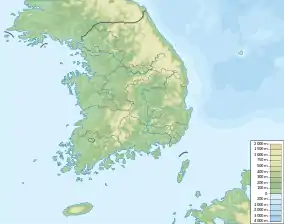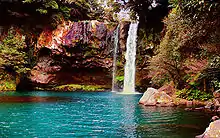Cheonjiyeon Waterfall
Cheonjiyeon Waterfall is a waterfall on Jeju Island, South Korea.[1] Literally, the name Cheonjiyeon means sky (Ch'eon) connected with land (ji).[1] It is one of the main tourist attractions on Jeju-do.[2][3] It is 22 m (72 ft) high and 12 m (39 ft) wide.[4][5] Though water always falls in one particular area, depending on the amount of recent rain, the water may spread out.[2] At the bottom of the waterfall is an artificial pond that is 20 m (66 ft) deep.[5] Two small dams help keep the water at a specific level.[2] Large volcanic rocks form landbridges that allow tourists to pose for photographs in front of the falls.[6] These falls are characterized by its trachyte andesite rocks.[7] The source of Cheonjiyeon Waterfall is a spring that comes out of the floor of the Somban Stream.[8] The stream Yeonhee-chun is the source of the waterfall.[9] The waterfall is one of the three famous waterfalls of Jeju, the other two being Cheonjeyeon Waterfall and Jeongbang Waterfall.[2]

| Cheonjiyeon Waterfall | |
|---|---|
 Location of Cheonjiyeon on the map | |
| Location | Korea, Jeju Province |
| Coordinates | 33°14′49.0″N 126°33′15.9″E |
| Total height | 22 m (72 ft) |
| Number of drops | 1 |
| Total width | 12 m (39 ft) |
| Cheonjiyeon Waterfall | |
 Cheonjiyeon Waterfall at Night | |
| Korean name | |
|---|---|
| Hangul | 천지연폭포 |
| Hanja | 天地淵瀑布 |
| Revised Romanization | Cheonjiyeon Waterfall |
| McCune–Reischauer | Ch'ŏnjiyŏn Waterfall |

In order to reach the waterfall, visitors must walk on a landscaped trail.[2] Near the beginning of the path is a traditional Korean raft called t'e-u (테우), symbolizing Korean culture.[2] It is the most popular at night, because the falls are illuminated.[5] At night, the "Hidden Face," a formation of rocks, may be visible with the night lights, and the falls are popular for lovers.[2][5] The Cheonjiyeon Waterfall is also known for its diverse plant and animal life, as the path to the waterfall goes through a garden of subtropical plants.[1][4][5] Migratory ducks,[2] Elaeocarpus sylvestris var. ellipticus (Natural Monument no. 163), Psilotum nudum, and Castanopsis cuspidata var. sieboldii, Xylosma congestum, and Camellia are some examples of the flora and fauna around the falls.[10] Just before reaching the falls on the path, one must cross a bridge from which a wide variety of koi fish can be seen below.[6] Along the way are three piles of stacked or balanced rocks that are a common sight throughout the whole of South Korea. In olden days, a person would place a small stone under a larger stone and pray for the health and prosperity of their family.[6] Its pond is known for being a habitat of the marbled eel (Anguilla marmorata), which is mainly active at night.[4] Known as the Mutae (무태) eel, it is classified in Korea as Natural Monument no. 27.[1][5]
See also
References
- Lee, Cecilia Hae-Jin. (2008). Frommer's South Korea. Hoboken, NJ: Wiley. pp. 392. ISBN 978-0-470-18191-1.
- "Cheonjiyeon Waterfall Travel Guide". lifeinkorea.com. Archived from the original on 15 May 2011. Retrieved 4 January 2011.
- Park, Yumi; Njite, David (2010). "Relationship between Destination Image and Tourists' Future Behavior: Observations from Jeju Island, Korea". Asia Pacific Journal of Tourism Research. 15 (1): 1–20. doi:10.1080/10941660903510024.
- "Cheonjiyeon Waterfall on Jeju Island in South Korea" (PDF). The Global Lion: 12. December 2010. Archived from the original (PDF) on 2011-07-20. Retrieved 2011-01-04.
- "Cheonjiyeon Waterfall Jeju Travel to Cheonjiyeon Waterfall Jeju Cheonjiyeon Waterfall in Jeju". AsiaRooms.com. Retrieved 4 January 2011.
- "Three Most Famous Waterfalls in Jeju Island". centervacation.com. 2011. Archived from the original on 14 December 2010. Retrieved 5 January 2011.
- "Jeju: Cheonjiyeon Fall". Busan Port International Passenger Terminal. 2005. Archived from the original on 26 March 2012. Retrieved 5 January 2011.
- Heo, Ji-yun (16 September 2009). "KCTV: Jeju's Seogwipo Formation & Cheonjiyeon Waterfall". Retrieved 5 January 2011.
- Oh, Duck Chul; Choi, Young Chan; Ko, Yong Ku (1992). "An Investigation of the Water Quality of the Streams in Sogwipo City". 한국육수학회지. 25 (1): 20–30.
- "MSK's 50th Anniversary International Symposium on Microbiology 2009 - Tour Programs". Archived from the original on 5 October 2011. Retrieved 5 January 2011.
External links
| Wikimedia Commons has media related to Cheonjiyeon Waterfall. |